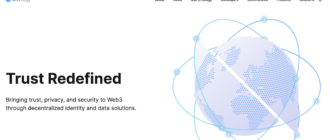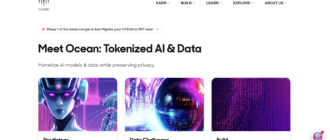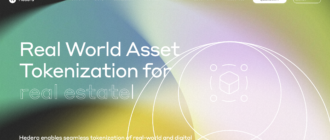Cardano emerges as a groundbreaking project in the blockchain space, aiming to balance the scales between regulatory oversight and user privacy by combining pioneering technologies. Founded with the ambition of providing more secure, scalable, and sustainable blockchain architecture, Cardano represents a significant stride towards achieving a decentralized and inclusive digital economy.

Project History
The journey of Cardano began in 2015, spearheaded by Charles Hoskinson, a co-founder of Ethereum. Developed by IOHK (Input Output Hong Kong), Cardano’s launch in September 2017 marked a meticulous approach to blockchain development, distinguished by peer-reviewed research and evidence-based methodologies. The project’s development phases are uniquely structured into stages named Byron, Shelley, Goguen, Basho, and Voltaire, each focusing on foundational aspects, decentralization, smart contracts, scalability, and governance, respectively.
What is Cardano?
Cardano is a third-generation blockchain platform designed to efficiently handle smart contracts, making it a direct competitor to Ethereum. It aims to solve common blockchain issues like scalability, interoperability, and sustainability through an academically supported, high-assurance codebase and a layered architecture. This foundation allows for the development of services and solutions that can integrate legal, financial, and social systems seamlessly.
How Cardano Works?
Cardano is engineered using a groundbreaking, multi-layer architecture that separates the accounting of transactions from the computational layer where smart contracts and applications run. This architecture includes the Cardano Settlement Layer (CSL) and the Cardano Computation Layer (CCL), each designed to handle specific functions within the ecosystem. The CSL processes ADA transactions quickly and efficiently, while the CCL provides the flexibility necessary for running diverse smart contracts and decentralized applications, facilitating updates without disrupting the network’s operations.
Cardano Blockchain
The blockchain itself is built using Haskell, a functional programming language known for its high degree of fault tolerance. This choice reflects Cardano’s emphasis on security and robustness, integral for financial applications. Unlike many blockchains that use a single-layer system for both transactions and applications, Cardano’s two-layer system allows for easier maintenance and upgrades, as well as improved scalability by handling different types of data separately.
Technical Details
Technical innovations in Cardano do not stop at its consensus algorithm. The network also introduces several other novel features aimed at enhancing functionality and user experience. One such feature is Plutus, a purpose-built smart contract development language and execution platform that leverages the functional programming approach of Haskell. Plutus is designed to ensure higher levels of security and to enable formal verification of contracts, providing assurances that the contracts do exactly what they are programmed to do without errors.
Additionally, Cardano’s ledger supports the concept of metadata which allows users to attach data to transactions, thus extending the use cases of the blockchain beyond simple fund transfers. This is especially useful in systems of verification like supply chain tracking, where additional information needs to be reliably associated with transactions.
What is Ouroboros?
Ouroboros is the innovative consensus algorithm at the core of the Cardano blockchain, representing a major breakthrough in the field of blockchain technology. As a proof-of-stake (PoS) protocol, Ouroboros diverges significantly from the proof-of-work (PoW) mechanisms that underpin older blockchains like Bitcoin. Its development is distinctive as it was the first blockchain consensus protocol based on rigorous academic research, with its design undergoing peer review and presented at leading cryptography conferences.
The Role of Ouroboros in Cardano
Ouroboros is integral to the operation and security of the Cardano network. It facilitates the process of reaching consensus among network participants on the state of the ledger, ensuring that all transactions are verified and agreed upon without a central authority. The protocol is designed to be energy-efficient, sustainable, and capable of supporting a global blockchain network with minimal environmental impact.
Technical Mechanics of Ouroboros
The operation of Ouroboros divides time into epochs, which are further subdivided into slots, akin to discrete time intervals. Each slot lasts approximately 20 seconds, although this can vary based on network conditions. An epoch in Cardano typically spans five days. Within each slot, a slot leader is randomly selected from the pool of ADA stakeholders; these leaders are responsible for adding a new block to the Cardano blockchain.
The selection of slot leaders is weighted by the number of ADA tokens a participant is staking, meaning the more ADA you stake, the higher your chances of being selected as a slot leader. Importantly, the protocol uses a multiparty computation system to ensure that this selection process is secure, random, and equitable.
Security and Efficiency Features
Ouroboros stands out for its security features, which are designed to protect against common vulnerabilities in blockchain networks, such as the 51% attack. In such attacks, a user or group gains control of a majority of the network’s mining power in PoW systems, enabling them to manipulate transaction verification. Due to Ouroboros’ staking model, executing a 51% attack would require obtaining at least 51% of the staked ADA, which would be prohibitively expensive and likely cause the value of ADA to plummet, making the attack counterproductive.
Furthermore, by eliminating the need for energy-intensive mining activities, Ouroboros is much more energy-efficient compared to PoW protocols. This design aligns with the growing demand for sustainable and eco-friendly blockchain solutions, particularly important as global awareness of environmental issues increases.
Future Developments
Ongoing research and development are expected to further enhance Ouroboros. Planned upgrades aim to increase scalability, introduce side chains, and optimize network throughput. These improvements will help Cardano accommodate a broader range of applications and higher transaction volumes, reinforcing its position as a leading platform for sustainable and scalable blockchain solutions.
Overall, Ouroboros not only underpins the operational integrity of the Cardano network but also exemplifies the possibilities of combining academic rigor with practical blockchain applications, setting a new standard for future blockchain innovations.
Tokenomics of Cardano: Understanding ADA
ADA: Token or Coin?
ADA is the native cryptocurrency of the Cardano blockchain, functioning primarily as a coin rather than a token. As a coin, ADA is used within the Cardano ecosystem to conduct transactions, pay for services, and participate in the network governance through staking. Unlike tokens, which are typically issued on top of another blockchain’s infrastructure and represent assets or utilities, ADA is integral to the Cardano blockchain’s own operation and security.
Emission Model and Supply Details
Cardano features a thoughtful emission model designed to balance the long-term availability and value of ADA. The maximum supply of ADA is capped at 45 billion coins. This cap is strategic, aimed at preventing inflation while ensuring enough supply to facilitate widespread adoption and use. The distribution of ADA follows a predefined schedule released during the network’s launch, where a certain amount of ADA is released per epoch (each lasting five days) to reward stakeholders and support network operations.
Staking and Incentives
Cardano adopts a staking mechanism where ADA holders can participate in the network’s operation by staking their coins either directly in a staking pool or by delegating their stakes to existing pools. This process is integral to the network’s PoS consensus mechanism, Ouroboros, as it secures the network and validates transactions. Staking ADA not only contributes to network security but also rewards participants with additional ADA, providing a financial incentive to maintain and support the network’s integrity and performance.
ADA’s Market Performance
The value of ADA, like most cryptocurrencies, is subject to market conditions and investor sentiment. It has experienced significant volatility, a common trait in cryptocurrency markets, reflecting shifts in investor expectations, broader economic factors, and changes within the Cardano network itself, such as major updates or technological advancements. The pricing of ADA also reflects its perceived utility and potential for broader adoption, influenced by the ongoing development and deployment of Cardano’s technology in various applications.
Long-term Economic Strategy
Cardano’s long-term economic strategy involves fostering a sustainable ecosystem where ADA serves as a key medium of exchange, value store, and a tool in governance. This strategy is supported by ongoing technological improvements that enhance network capabilities and by partnerships that expand the use cases for ADA in various sectors, including finance, supply chain, and public administration.
The economic design of ADA is crafted to ensure that as Cardano’s utility and adoption increase, the value and demand for ADA will align with the growth of the network, supporting both short-term functionality and long-term value appreciation. This approach positions ADA not just as a cryptocurrency, but as a fundamental element of a growing blockchain-driven economy.
Where to Buy ADA?
ADA, the native coin of the Cardano blockchain, is widely accessible on numerous cryptocurrency exchanges. For those looking to purchase ADA, here are some of the most reputable platforms where it is currently available:
- Binance: One of the largest and most well-known cryptocurrency exchanges globally, Binance offers robust trading options for ADA, including direct purchases and trading pairs with other cryptocurrencies and fiat currencies.
- HTX (formerly Huobi): HTX supports ADA transactions and is known for its secure platform and a range of crypto-financial services beyond just buying and selling.
- MEXC Global: Known for offering a wide variety of trading pairs, MEXC Global provides options for trading ADA against other cryptocurrencies and fiat via a user-friendly interface.
- Bybit: This exchange has gained popularity for its easy-to-use interface and strong customer support. Bybit offers ADA trading and is known for its derivative and spot markets.
- KuCoin: KuCoin is known for user-friendly trading and relatively low fees. It supports a wide range of cryptocurrencies including ADA, providing various trading pairs for users.
- Bitfinex: Offering a suite of order types and trading tools, Bitfinex is a platform that caters to professional traders but is also suitable for newcomers. ADA can be traded here against other cryptocurrencies and fiat currencies.
These exchanges are chosen for their reliability, range of trading options, and ease of access. Users should consider their specific trading needs and geographic restrictions when choosing an exchange.
Where to Store ADA?
For storing ADA, a range of wallets are available, each offering different features to cater to various needs such as security, convenience, and functionality. Here are some recommended options:
- Daedalus Wallet: This is a full-node desktop wallet developed by IOHK, Cardano’s parent company. It downloads the full Cardano blockchain and independently validates every transaction in its history. This provides a high level of security but requires more memory and time to sync with the blockchain.
- Yoroi Wallet: Designed as a light wallet, Yoroi is a browser extension that allows users to interact with their ADA without the need to download the blockchain’s full history. It’s a simple, fast, and secure way to manage ADA, suitable for daily transactions.
- Ledger Nano S/X: For those preferring hardware wallets, Ledger Nano offers an offline, highly secure option for storing ADA. When combined with Daedalus or Yoroi, it provides an additional layer of security by keeping the private keys offline and protected even when the wallet is connected to a computer.
- Trezor Model T: Another secure hardware wallet option that supports ADA. It integrates with third-party software wallets for an easy-to-use experience while maintaining strong security by keeping private keys offline.
- Adalite: Adalite is a lightweight web wallet that allows you to access your ADA holdings through a user-friendly interface without the need to store the blockchain. It supports both hardware and software wallets, providing flexibility and security.
Each of these storage solutions offers different benefits, from the robust security of full-node wallets like Daedalus to the convenience and quick access of light wallets like Yoroi and hardware wallets like Ledger Nano S/X, which provide security for your ADA by keeping it offline. Users should consider their specific needs, such as the level of security required and the frequency of transactions, when choosing the appropriate wallet.
Future Outlook and Development Projections
Cardano’s roadmap is expansive, with ongoing projects focusing on scalability solutions like Hydra, which aims to exponentially increase transaction speeds through off-chain transactions. The adoption of Cardano’s smart contract capabilities and the potential expansion into enterprise solutions and governmental systems provide a promising outlook for its growth and applicability in various sectors. Furthermore, its commitment to scientific rigor and community-driven governance continues to attract both academic and commercial interest.
Conclusion
As a beacon of innovation, Cardano is poised at the cutting edge of blockchain technology. With a strong commitment to research-driven development and an active community, Cardano’s strategic approach to solving modern financial challenges makes it a key player in the future of decentralized applications. For advanced users and investors in the cryptocurrency space, understanding the complex interplay of Cardano’s technological features and market dynamics is essential for evaluating its long-term potential and strategic positioning in the digital economy.






